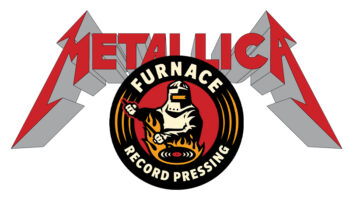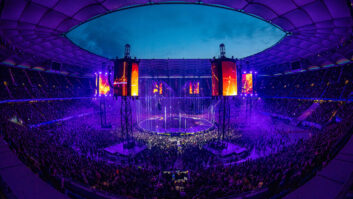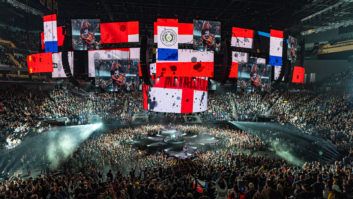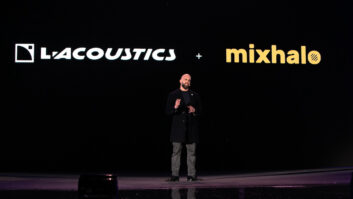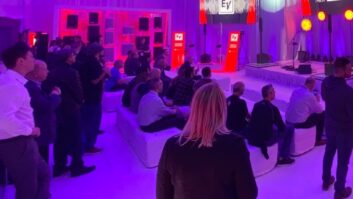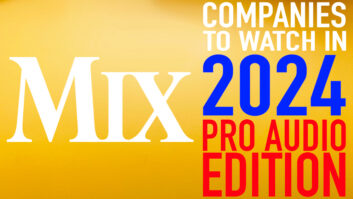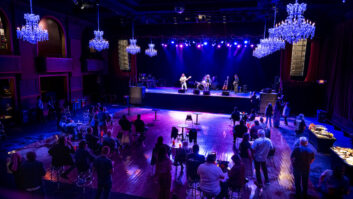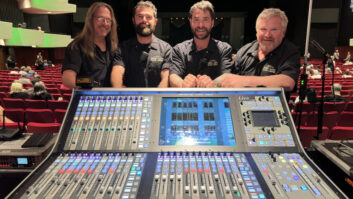Michael Kamen is sitting back, looking over the sea at his home in Tuscany, Italy. He’s coming off a tremendous first half of 1999, during which he composed the score for the animated feature Iron Giant and worked with the multi-Platinum rock band Metallica on an evening’s collaboration with the San Francisco Symphony. The balance of this year will be spent composing “The New Moon in the Old Moon’s Arms-A Symphony for the Millennium,” which was commissioned by Leonard Slatkin and the National Symphony Orchestra. The symphony will premiere at the Kennedy Center in Washington, D.C., on January 11, 2000.
While 1999 was a busy year for the composer/arranger, it was by no means his breakthrough year-his reputation is already well-established from his extensive film scoring work, which includes Brazil, Mona Lisa, all four films in the Die Hard and Lethal Weapon series, Robin Hood: Prince of Thieves, What Dreams May Come and Mr. Holland’s Opus, among many others. He’s also worked with a bevy of musicians ranging from Bryan Adams on the hit song “Everything I Do (I Do It For You)” to Eric Clapton, David Bowie and Bob Dylan.
With the Metallica collaboration, the “Symphony for the Millennium” and the Iron Giant score, this seems a nice way for you to finish off the century.
It’s been very rewarding to be working on these three projects. I’m very happy that you mentioned them as a triptych, because they seem that way. When it comes to working in these disparate arenas, what drives you?
The fact that they are not very different, that they are all the same. It’s music, you know, which is what I sleep and breathe and dream. I never did distinguish between one kind or another kind-it’s just the bits that I could remember and the bits I couldn’t remember or wanted to remember, wished I could remember, which is what I’m into now, writing my symphony. That’s the realization that has occurred to me in the barrage of work that has been Metallica, Iron Giant and the symphony. I’ve suddenly turned philosophical and said, “Oh, yeah, what it’s all about is that I think they are the same thing.” I think we’re the same people, we’re musicians and we express our feelings. Our emotions are different, but our way of expressing them musically isn’t really.
Is there something specific-be it music, art or literature-that inspires you while studying how to bring out a character in a film?
I guess I have models that I do respect tremendously, but I don’t think of consciously when I’m looking at something else. Musically, Bach is my god, I suppose. I cannot say that I invoke him when I’m doing most film scores, but the spirit of music is what I do, and I want to convey my enjoyment of it in the different languages I speak. And they are different languages. I’m not trying to pretend that Metallica and Iron Giant and a symphony are one in the same. We’re not beige, everybody has their own personality, but it makes a great combination.
You mention Bach-is there anyone else in particular that you turn to for inspiration while going from, say, an action score in Die Hard to a romantic Robin Hood to a robotic Iron Giant?
No, it’s really between Bach and Brahms, I’m afraid [laughs], and it stays in that territory. I go to Stravinsky very willingly and fairly often, and I go to Mozart, but so do we all. I don’t go to them to take, steal or borrow. I go to them to learn.
How about pop musicians?
I don’t go there. [Laughs.] How about them? Aren’t they great?
Nothing there for you to learn, though?
I learn every day. These are the people I work with all the time. I certainly learn from every encounter with a musician, and guys like Metallica who have honed their personalities and have spoken as a team for so many years in such a distinct, really scary way-great correspondents.
I remember sharing stages with wonderful people, and that’s what life as a musician is about, the capacity to have that experience. If you’re a married man, you shouldn’t really be playing the field, but if you’re a musician and you need contact with other musicians, you can do that. It’s like making love. [Laughs.] Don’t take that literally.
And they are also, like you, very passionate about what they do.
Oh, yeah, they believe in it totally. They know what they are about. This was very brave of them to take on an orchestra. I took it more seriously than maybe I had to; I don’t know. To make an orchestra rise to the energy level and performance level of Metallica is asking for a lot of notes on paper.
Iron Giant seems very retro and yet futuristic. How do you communicate that in the score?
I think that films that seem retro seem that way only because they harken on the earlier methods of making films, which were to stimulate the imagination instead of sort of supply it in every corner with a trickle of information. They inspire the imagination. When you look at Casablanca, when you look at films of that ilk, they didn’t think they were making a classic-there was no grandeur about it. They just did their job. It’s about the work, it’s about the work, it’s about the work. When you see a film as beautiful as Iron Giant, the only possibility is to react in a very honest, musical way to the story. I love the film. I was working on the film, trying to write music, and found myself just drifting and watching it when I should have been writing.
Is there a difference between scoring for animated features like Iron Giant and more traditional films like Robin Hood?
Well, no. In a way, Robin Hood was more like a cartoon in many ways, and it needed wall-to-wall music. Robin Hood was two hours and 11 minutes of film, and there was two hours and three minutes of music, or some ridiculous figure like that. I loved making the music for it, and I was very happy to never take the horn out of my mouth, but it isn’t necessary all the time for music to tell the story.
The rumor is that animated films require music wall-to-wall. I had never done an animated film and was very curious. They sent it to me with a temp score, as they always do, and it was a daunting temp score. It had Bernard Herrmann in it, it had some great Jerry Goldsmith cues, and some well-known other music that they often cut into films when they’re making them. It comes under the heading of “never show a fool unfinished work.” If you have an unfinished film, show it with finished music, if you’re showing it to the people who have to sell it. [Laughs.] In any case, in the process for this film it was possible to just pay attention to the film and not have to go wall-to-wall.
Given your catalog of work, I’m imagining you sitting around an incredible array of synthesizers with thousands upon thousands of sound modules. What is your setup?
No, I’m an oboe player. I’ve got an oboe, an English horn; I’ve got an oboe DM bore. I have a Kurzweil 2500, which generally serves as the master synthesizer. It’s usually played on a Studio 900 or some Kurzweil keyboard. A piano, Digital Performer, a lot of Macintoshes, and I’m home. I’m in Italy right now with a rig that consists of a 2500, my PowerBook G3, a whole sh-load of music paper and a keyboard. Music is portable, finally.
Is there a specific Michael Kamen theme that comes from 1975, when you did your first score, to 1999? Is there a common thread through all of this?
[Laughs.] Well, Michael Kamen is the common thread, for the most obvious reason. My life goes through many changes, but I’d like to think that I can remain, as much as possible, the same human being and maybe grow a little, learn a bit. I would love to sound pontifical and in control, but I think that the truth is that I’m just open to whatever happens, and it’s always seemed to happen beautifully. Of course, I nudge it in a direction or two from time to time. So, I’m not totally without responsibility. But, it’s about the work, it’s about the work, it’s about the work. You just do each one as if it’s the only thing in the world and make as complete a statement as you can. In that sense, while the symphony is more difficult than a film score, it’s the same thing. I’m trying to make a complete statement with the symphony, which rivals the complete statement of a film without the film, because that’s what we do in the 20th century, and I think that’s what we’ll do in the 21st.
So, what is the symphony about?
I decided I better tell a story, and I may regret it, because I haven’t finished a damn thing, and I’ve got a month or so. The story of the symphony goes back a thousand years, cause it’s a millennium symphony. It tells the story of the Anasazi Indians, who lived in the canyons of the Southwest, and exactly a thousand years ago, they left. We don’t know why, we don’t know where they went, but it tells this story because they left millions of drawings of themselves and their lives and their beautiful pueblo homes, pottery and other traces of their civilization. I made the flute player Kokopeli the lead figure in this dance that takes you back a thousand years. He takes them out of the canyon, and the second and third movements are with them on the Earth. Finally he calls the spirits together, and they leave the planet.
It’s basically saying that human beings will still be human beings a thousand years from now. We’re still the same spirit, and we’re driving for the same reason. The name is from an Iroquois name that describes the last phase of the crescent moon as it lightens up the darkened new moon to come. The Indians call it “The New Moon in the Old Moon’s Arms,” and that’s the name of my symphony. It’s a glimpse of the future in light of the past.
I’m looking forward to hearing it.
I’m looking forward to finishing it.
Can you foresee what the next 50 years of music is going to be like? Do you have inkling in your heart?
I just hope it’s in C Major. [Laughs.] That’s what I prefer. No predictions about music; it will continue to confound us, I’m sure.
On April 21 and 22, 1999, Bay Area heavy metal fans enjoyed the unprecedented treat of two concerts by local heroes Metallica, accompanied by the San Francisco Symphony Orchestra playing arrangements by Michael Kamen. Both shows were recorded for later TV broadcast and a DVD release, and recording facilities included the Westwood One and Effanel digital remote recording trucks, plus a supplementary truck containing analog multitracks for the band recordings.
Engineers Randy Staub and Biff Dawes recorded band and ambience inputs via the Westwood One truck’s Euphonix console, with Bob Rock producing, while Steve McLaughlin used the Effanel truck’s Neve Capricorn console to mix and record a total of 96 orchestra mics and DIs, while also providing various submixes for the Westwood One truck, plus FOH and onstage monitor mixers.
All electric instrument amplifiers were miked offstage and, for the first time, Metallica performed on a stage almost totally free of wedge monitors, relying instead on in-ear mixes. A few guitar wedges were deemed essential, and the drums were, of course, acoustic, so all orchestra members were provided with 30dB hearing protectors and single-muff headphones. According to Effanel remote engineer and Capricorn tech John Bates, the orchestra recordings from the first night’s show were relatively clean and tuneful, despite the proximity to a large and loud acoustic rock drum kit, but Bates admitted that intonation was less than perfect, understandable under the circumstances.
Though recording to dual 48-track digital recorders necessitated a significant amount of premixing, the producers kept the option to mute string “clams” at a later date by separately recording string pairs to 24 tracks of multiple DA-88s. Thus, a flawed string track on the multitrack that contained a premix of five or more mics could be reconstituted from the DA-88s, less the offending player and his or her chair partner.
Except for some ambience mics and a Decca Tree setup, all of the microphones onstage were supplied by Audio-Technica and Greg Jackman, a British company. The Jackman mics, similar in size and appearance to miniature Countryman and Sennheiser models, include a small mounting bracket that attaches to the tail piece of a string instrument, and a flexible gooseneck-like extension that allows the capsule to be inserted through the F-hole into the instrument’s internal cavity. This arrangement allows far more separation than is possible with traditional distance miking methods.
The layout of the orchestra on the stage of the Berkeley Community Theatre was more or less conventional, except that first violins were placed downstage on either side of the centrally located drumkit. Conductor/composer Michael Kamen faced the orchestra from a podium stage right of the drums, and multiple vocal microphone positions allowed singers James Hetfield, Kirk Hammett and Jason Newsted to “duet” with sections of the orchestra.
FOH and monitor systems were provided by Audiotek. V-DOSC columns were flown either side of the stage, supplemented by flown subwoofer stacks (limited space on- stage prohibited ground stacking). The FOH console was a Midas XL4, monitors Yamaha PM4000.
Unusual in a live recording setup, there were no splitter systems in use. DI and microphone inputs were picked up at the stage via remote mic pre’s and D/A converters and sent to the Westwood One and Effanel trucks over fiber-optic cables. Pre- and post-fader channel and bus signals were then returned to the stage for the FOH and monitor mixers, and various premixes were distributed to the video, lighting and comms systems. Footpedals at his podium position allowed Kamen to switch easily among three different communications/monitoring setups. Since Effanel’s Neve Capricorn is equipped with only 80 mic pre’s and D/A converters, inputs for channels 81-96 were run into Millennia mic pre’s onstage and sent to the truck over analog links.
